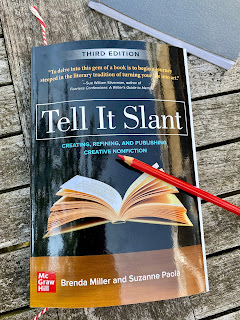The Manual | Tell It Slant by Brenda Miller and Suzanne Paola | Karen Kao
 |
| Tell It Slant by Brenda Miller and Suzanne Paola |
For writers
One definition of creative nonfiction is “true stories, well told.” Tell It Slant calls it “tricky business.”
"In creative nonfiction—more so, perhaps, than in any other genre—readers assume a real person behind the artifice, an author who speaks directly to the reader. Just as in spoken conversation, it’s a symbiotic relationship. The reader completes this act of communication through attention to the author’s story, and the author must establish right away a reason for the reader to be attentive at all."
Brenda Miller and Suzanne Paola, Tell It Slant: Creating, Refining, and Publishing Creative Nonfiction (McGraw Hill 2019)
The art of writing successful creative nonfiction, then, is a two part process. First, to find a story worth telling. Second, to tell it as well and as honestly as you possibly can. Tell It Slant bursts with writing prompts and exercises designed to help the aspiring essayist “unearth” her material. For example, if you know you’d like to write an essay about the body (yours or someone else’s), you could do this:
"Take an inventory of the scars or marks on your body. How were they received? How do these external scars relate to any internal “markings” as well?"Tell It Slant also includes a reading list (online and in print) as well as an anthology of essays. These readings serve as illustrations of why and how essays work.
"The more you read and study, the more you will discover that creative nonfiction assumes a particular, creating self behind the nonfiction prose. When you set about to write creative nonfiction about any subject, you bring to this endeavor a strong voice and a singular vision. This voice must be loud and interesting enough to be heard among the noise coming at us in everyday life."
For teachers
I suspect, however, that Tell It Slant will be more useful to teachers than aspiring essayists. For example, a teacher could frame her creative nonfiction discussion by topic. Say, writing the family or the arts. Or choose, as I like to do, to see the essay as a three-dimensional form.
"The basket. The body. The canoe. The page. Each of these vessels has a form, a shape to which its purpose is intimately related. Each carries, each holds, and each transports. However, none of these vessels can be defined solely by their contents; neither can their purpose be understood strictly as utilitarian. Rather, the craft involved in creating such a vessel, the care and knowledge it takes to create the structure and shape necessary to convey, is inseparable from the content the vessel holds. To pay attention only to the contents would be to ignore the very relationships that such vessels sustain."
Theresa Warburton and Elissa Washuta, Shapes of Native Nonfiction as quoted in Tell It Slant
I’ve picked up my copy of Tell It Slant in preparation for teaching the lyric essay. For me, this was a great way to place my chosen form within a larger creative nonfiction context. And while I could not make much use of the writing prompts for my class, other teachers could.
To be continued
Tell It Slant comes with its own website with sample syllabi. It is not as robust as I would have liked. I suspect the pandemic is to blame. One of the online resources cited in Tell It Slant did not survive lockdown. It feels positively quaint to read the group exercises that presume in-person contact.
"Variation for a Group: Go out and gather objects individually, but come back together as a group to sift through the pile. Use each other’s objects to create three-dimensional collages. Then write for one hour to create a collage essay using these objects as a guide."To be fair, the world of creative nonfiction is evolving even faster than Covid-19 variants. Think of the wild and wonderful work being done in the La La Land of mixed-media, cross-genre, hybrid and digital works. Think of Claudia Rankine’s Citizen, itself a hybrid work of visual and textual art, as well as her video collaborations with John Lucas. There is more to come. Tell It Slant is as good a field guide as any to explore what lies ahead.
Comments